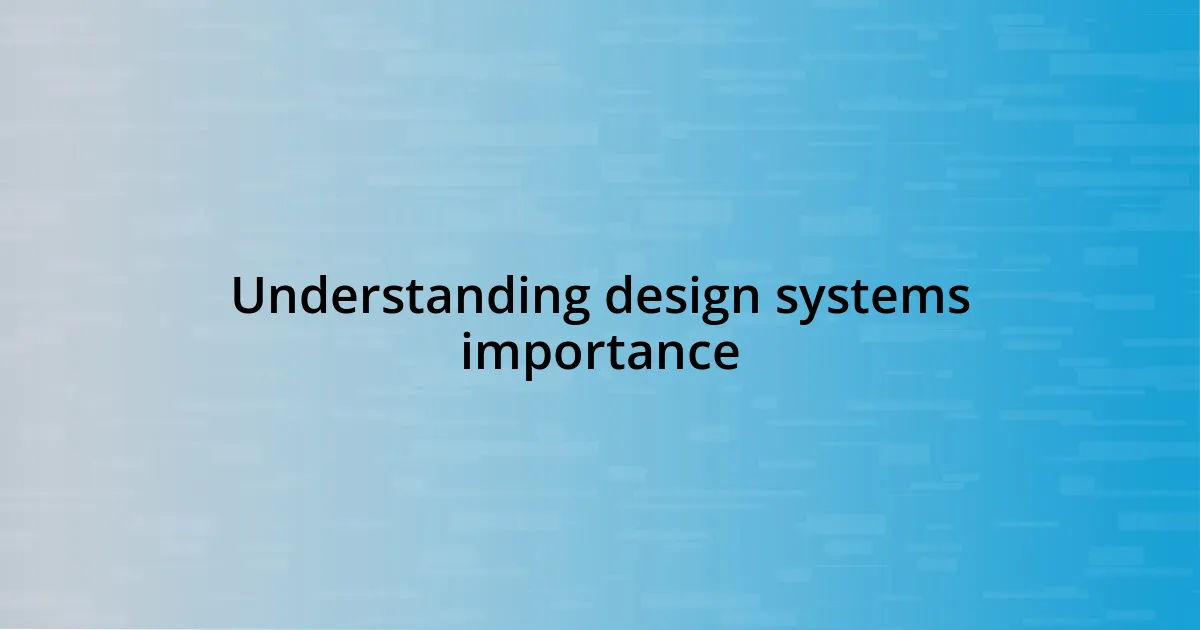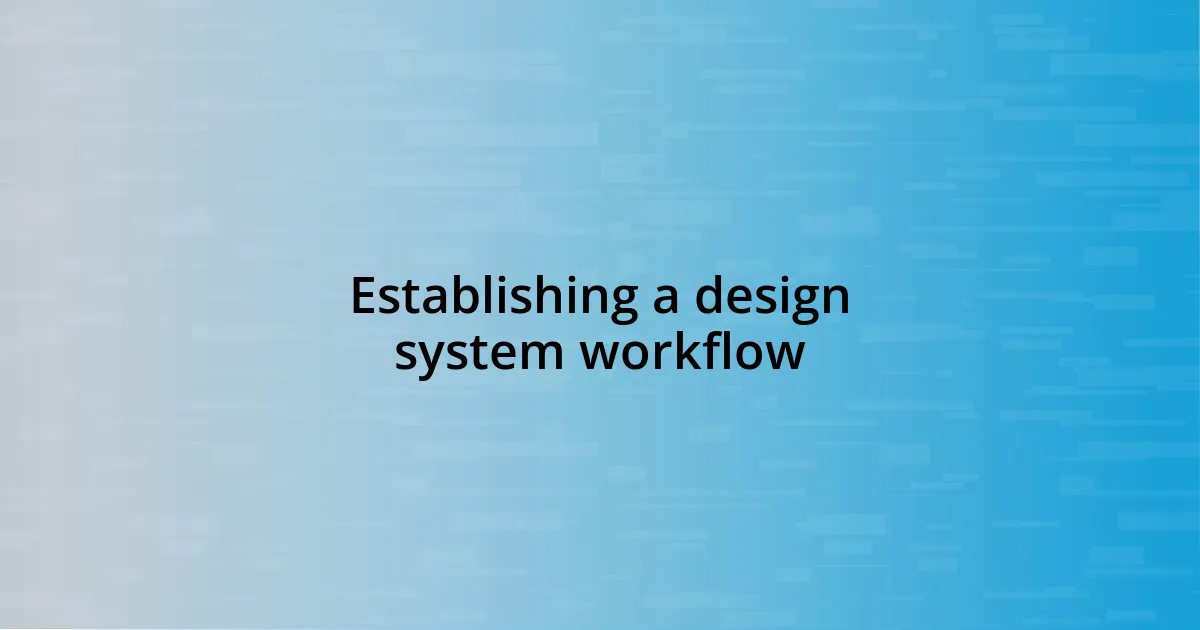Key takeaways:
- Design systems enhance consistency across projects, improve user experience, and foster team collaboration.
- Establishing a clear workflow with defined roles and regular feedback loops boosts productivity and ensures design guidelines are upheld.
- Creating standardized design patterns and thorough documentation helps maintain a cohesive visual language.
- Measuring the effectiveness of a design system through user feedback and usage metrics informs continuous improvement and adaptation.

Understanding design systems importance
When I first delved into the world of design systems, I was struck by their power to create consistency across projects. Isn’t it satisfying to see how a well-defined design system can streamline the design process? This consistency not only enhances user experience but also fosters collaboration among team members, which I found invaluable during my own design endeavors.
I remember a time when our team was working on a large-scale application, and we struggled with mismatched styles and confusing layouts. Introducing a design system transformed our workflow, reducing redundant discussions about design choices. This shift in approach significantly boosted our team’s morale and productivity. Have you ever felt the chaos of design misalignment? A design system can be the anchor that keeps everyone grounded and focused.
Moreover, a strong design system serves as a living document that evolves with your brand. I’ve witnessed firsthand how a design system can adapt to changing user needs while maintaining brand identity. Reflecting on my experiences, I can’t emphasize enough how empowering it is to have a structured guide that inspires creativity rather than stifles it. This balance opens the door for designers to innovate while still adhering to a coherent visual language.

Establishing a design system workflow
Establishing a design system workflow is often one of the most critical steps I undertake in the process. I’ve learned that beginning with a clear structure lays the groundwork for efficiency and consistency. For instance, during my last project, we created a visual hierarchy that outlined every element’s purpose—from buttons to typography. This clarity allowed my team to spend less time debating design options and more time focusing on user experience—an approach that truly resonated with the team spirit.
Along the way, incorporating feedback loops has been a game changer. I vividly recall a project where initial designs were met with ambiguity regarding function and aesthetics. By prioritizing regular sync-ups, we quickly identified areas needing revision, fostering an environment where everyone felt their input was respected. This collaborative workflow not only improved our output but also reinforced the importance of continuous improvement within the design system.
Moreover, defining roles within the workflow has proved invaluable. For example, having a dedicated “design advocate” ensured that design guidelines were upheld across various teams. I noticed that when team members clearly understood their responsibilities, the overall process flowed more smoothly. We began to see our design system as a shared asset rather than a set of rigid rules—a shift that breathed life into our projects and invigorated our creative spirits.
| Workflow Element | Description |
|---|---|
| Clear Structure | Outlining a visual hierarchy to guide design choices. |
| Feedback Loops | Regular sync-ups to encourage collaboration and improvements. |
| Defined Roles | Assigning specific responsibilities to ensure consistency. |

Creating consistent design patterns
Creating consistent design patterns is essential for maintaining a cohesive visual language. I remember grappling with mismatched button styles during one of my earlier projects. It was a frustrating experience, as it led to a jarring user journey where different components didn’t harmonize. To combat this, I implemented a set of standardized design patterns. This not only brought clarity to our visual elements but also fostered a sense of identity across the project, making everything feel more integrated.
Here are some key strategies I found helpful for creating consistent design patterns:
- Define Core Elements: Establish a set of foundational components, like buttons and input fields, that can be reused throughout the project.
- Documentation: Maintain thorough documentation that provides guidelines on how and when to use each design pattern, ensuring everyone is on the same page.
- Visual Style Guide: Develop a visual style guide that showcases various components in action, which helps the team visualize the end product.
- Regular Reviews: Incorporate periodic reviews of design patterns to assess their effectiveness and adapt as needed based on user feedback.
By focusing on these strategies, I’ve seen design teams not only maintain consistency but also inspire creativity, allowing designers to think outside the box while still delivering polished results.

Implementing a collaborative design process
Implementing a collaborative design process is something that resonates deeply with my experience. I often recall a project where we leveraged a shared brainstorming platform, allowing team members to contribute ideas in real time. The vibrant exchange of thoughts added a sense of excitement, transforming what could have been just another meeting into an engaging dialogue where everyone felt invested. Doesn’t it feel good when team members collaborate seamlessly, driving creativity and innovation together?
One of the best practices I’ve discovered is rotating roles during collaborative sessions. I remember a time when a junior designer stepped in as a facilitator during one of our workshops. It was enlightening! Their fresh perspective led to innovative ideas I hadn’t considered. This approach not only empowers all team members but also fosters a culture where diverse viewpoints are celebrated. How often do we pause and listen to fresh voices in our design discussions?
Encouraging iterative feedback rounds is another vital component. In a recent project, we implemented a weekly feedback cycle that involved stakeholders at every level. It was eye-opening to see how early insights could guide design adjustments, saving time in the long run. By consciously creating space for open dialogue, everyone felt their contributions mattered. This culture of collaboration transformed our final product and built a stronger team cohesion—who doesn’t want to be part of a team where every voice matters?

Measuring design system effectiveness
Measuring the effectiveness of a design system can often feel like navigating uncharted waters. In one project, we deployed a satisfaction survey to gauge user experience after implementing our design system. The results were enlightening; while some elements were praised, others fell flat, reminding me of how crucial it is to listen to user feedback. Have you ever found yourself surprised by user opinions? It’s a powerful realization that user perspectives can guide improvements in ways we might not anticipate.
I also value metrics like usage frequency and consistency across platforms. In one instance, I tracked how often specific components were utilized in our application. This helped us identify which designs resonated with users and which ones needed a refresher. It was fascinating to see how small modifications in a component could significantly enhance user engagement. Tracking these details doesn’t just improve the design; it transforms the overall user experience, making it more relevant and intuitive.
Seeking qualitative insights from team members can complement quantitative measurements beautifully. I remember facilitating a retrospective where team members shared their experiences homing in on the design system. The stories they told brought to light the emotional journey of using the system, providing context that raw data alone couldn’t offer. Isn’t it amazing how both numbers and narratives combine to create a more comprehensive understanding of a design system’s effectiveness? Engaging with both is key for continuous growth and adaptation.














